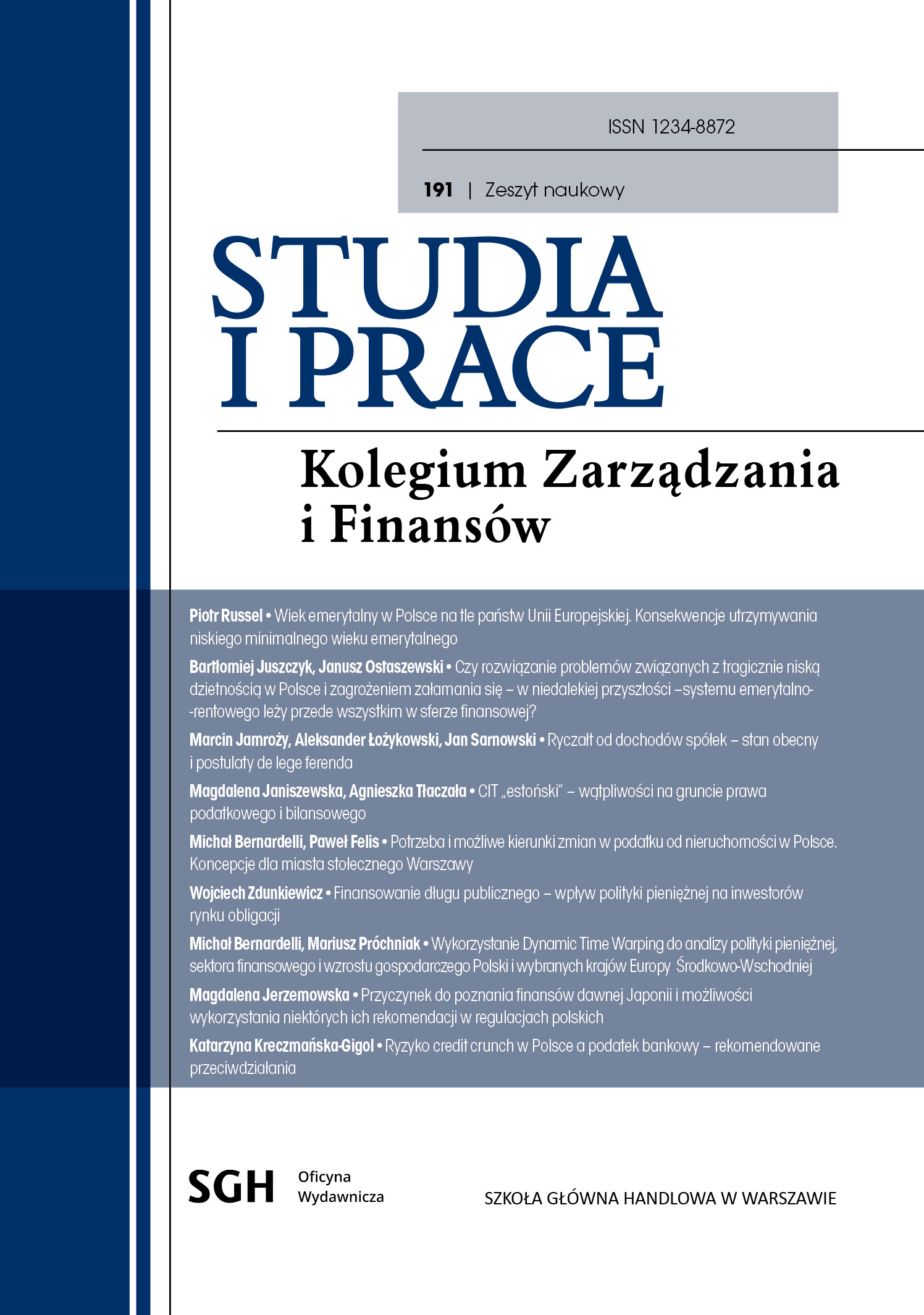CIT „estoński” – wątpliwości na gruncie prawa podatkowego i bilansowego
DOI:
https://doi.org/10.33119/SIP.2023.191.4Słowa kluczowe:
CIT estoński, ryczałt od dochodów spółek, podstawa opodatkowaniaAbstrakt
Celem artykułu jest przedstawienie wątpliwości powstałych na gruncie analizy przepisów dotyczących ryczałtu od dochodów spółek, zarówno na gruncie prawa podatkowego, jak i prawa bilansowego. Szczególnie problematyczne zdaje się być prawidłowe ustalenie podstawy opodatkowania podatkiem od osób fizycznych po stronie wspólnika otrzymującego zysk. Analiza interpretacji indywidualnych Dyrektora Krajowej Informacji Skarbowej wskazuje na sprzeczność stanowisk prezentowanych w tym zakresie. Wydawane interpretacje indywidualne nierzadko pozostają w sprzeczności również z objaśnieniami podatkowymi Ministerstwa Finansów z 23.12.2021 r. oraz z poglądami prezentowanymi w literaturze przedmiotu. Kwestia ta rzutuje na wysokość podzielonego zysku przypadającego wspólnikom tych spółek oraz wysokość należnego z tego tytułu PIT i tym samym skutkuje powstaniem ryzyka podatkowego po stronie podatnika. Na podstawie przeprowadzonej analizy literatury przedmiotu, aktów prawnych, wydanych dotychczas interpretacji indywidualnych oraz wyroków sądów administracyjnych sformułowano zalecenia co do przyszłego kształtu przepisów dotyczących ryczałtu od dochodów spółek, mające na celu eliminację wątpliwości interpretacyjnych na tym polu i tym samym sprawienie, by przedmiotowe przepisy stały się bardziej przejrzyste zarówno dla podatników, jak i organów podatkowych. Kolejnym krokiem po zmianie objaśnień podatkowych powinna być dyskusja nad zmianą układu sprawozdań finansowych jednostek stosujących ryczałt od dochodów spółek, gdyż w obecnym kształcie pozycja „zysku netto” nie może być traktowana równoważnie z kwotą przeznaczoną do podziału
Downloads
Bibliografia
1. Interpretacja indywidualna Dyrektora Krajowej Informacji Skarbowej z 15 lipca 2022 r., sygn. 0111 KDIB2 1.4011.156.2022.2. AR.
2. Interpretacja indywidualna Dyrektora Krajowej Informacji Skarbowej z 15 lipca 2022 r., sygn. 0114 KDIP2-1.4011.432.2022.4. MW.
3. Interpretacja indywidualna Dyrektora Krajowej Informacji Skarbowej z 18 lipca 2022 r., sygn. 0111 KDIB1-2.4010.232.2022.3. AW.
4. Interpretacja indywidualna Dyrektora Krajowej Informacji Skarbowej z 1 sierpnia 2022 r., sygn. 0113 KDIPT2-3.4011.393.2022.1. KS.
5. Interpretacja indywidualna Dyrektora Krajowej Informacji Skarbowej z 2 sierpnia 2022 r., sygn. 0113 KDIPT2-3.4011.411.2022.1. GG.
6. Interpretacja indywidualna Dyrektora Krajowej Informacji Skarbowej z 5 sierpnia 2022 r., sygn. 0113 KDIPT2-3.4011.381.2022.3. AK.
7. Interpretacja indywidualna Dyrektora Krajowej Informacji Skarbowej z 10 lutego 2023 r., sygn. 0113 KDIPT2-3.4011.940.2022.1. KKA.
8. Ustawa o podatku dochodowym od osób fizycznych z dnia 26 lipca 1991 r., Dz.U. z 2022 r., poz. 2647.
9. Ustawa z dnia 15 lutego 1992 r. o podatku dochodowym od osób prawnych, Dz.U. z 2022 r., poz. 2587.
10. Ustawa z dnia 29 września 1994 r. o rachunkowości, Dz.U. z 2023 r., poz. 120.
11. Wyrok WSA w Gliwicach z 14 lutego 2023 r., sygn. akt I SA/Gl 1178/2.
12. Wyrok WSA w Gliwicach z 16 lutego 2023 r., sygn. akt I SA/Gl 1171/22.
Wydawnictwa zwarte i artykuły prasowe:
1. Gierusz J. [2005], Koszty i przychody w świetle nadrzędnych zasad rachunkowości (pojęcie klasyfikacja, zakres ujawnień), ODDK, Gdańsk.
2. Hendriksen E., van Breda M.F. [2002], Teoria rachunkowości, Wydawnictwo Naukowe PWN, Warszawa.
3. International GAAP [2019], Generally Accepted Accounting Practice under International Financial Reporting Standards, Wiley.
4. Kaczmarek M. [2022], Estoński CIT w nowej odsłonie, cz. 1, Warunki stosowania ryczałtu od dochodów spółek, „Rachunkowość”, 6.
5. Kręski T. [2022], Estoński CIT – PIT od dywidendy można pomniejszyć już przy zaliczkach, LEX/el.
6. MSR 33, Międzynarodowy Standard Rachunkowości 33, Zysk przypadający na jedną akcję.
7. Olchowicz I., Jamroży M. [2018], Rachunkowość podatkowa. Analiza w zakresie podatku dochodowego od osób prawnych, Difin, Warszawa.
8. Przewodnik do Ryczałtu od dochodów spółek z dnia 23 grudnia 2021 r., Redakcja Departamentu Podatków Dochodowych Ministerstwa Finansów, Warszawa
9. Pustuł J. [2021], Ryczałt od dochodów spółek kapitałowych, czyli estoński CIT à la polonaise, „Przegląd Podatkowy”, 3.
10. Wądołek M. [2022], Zasady opodatkowania dywidend w PIT, w: Wądołek M., Guzek M., Nowacki J., Stefaniak M., Wysocki P., Estoński CIT w praktyce, Wolters Kluwer Polska, Warszawa









